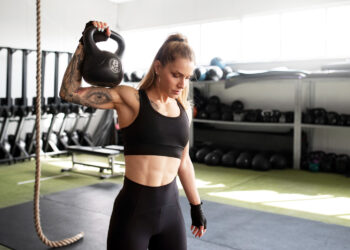As a veteran personal trainer with over 30 years of professional experience, I know abs and core training can be repetitive and boring. That’s because most people build their core workouts around the same old exercises, namely planks, sit-ups, and crunches.
Just thinking about doing those exercises is enough to make you feel uninspired, and it’s no wonder that many exercisers do very little core training or skip it entirely. That’s unfortunate because, of all the muscle groups in the human body, the core is arguably one of the most important.
Your core links your upper body to your lower body, so it plays a critical role in every movement and activity you perform. Plus, studies tell us that a strong core can help prevent and treat lower back pain (1).
The good news is that core training does not have to be time-consuming or tedious. In fact, you can achieve great results even if you limit yourself to a single exercise.
In this article, I introduce you to the hollow roll, a.k.a. the hollow roll to Superman. This single exercise will do more for your core strength than any number of sit-ups and crunches.
Hollow Roll Correct Form
There are two ways to do most exercises – the right way and the wrong way. The right way keeps the tension on the target muscles while being kind to your joints. In contrast, the wrong way is usually less effective and more likely to cause injury. Needless to say, when I’m working with my clients, I always insist on the correct form.
Level Up Your Fitness: Join our 💪 strong community in Fitness Volt Newsletter. Get daily inspiration, expert-backed workouts, nutrition tips, the latest in strength sports, and the support you need to reach your goals. Subscribe for free!
Follow these steps to ensure you do hollow rolls properly, safely, and for maximum effect!
- Lie on your back with your legs straight and arms above your head. Brace your core and press your lower back into the floor, i.e., a posterior pelvic tilt.
- Lift your legs, arms, shoulders, and head off the floor so your body is slightly curved, looking not unlike a banana.
- Roll sideways, flexing your body laterally to keep your arms and legs off the ground.
- Continue rolling until you are on your front. Extend your hips and shoulders so your arms and legs remain elevated.
- Roll back the way you came and then repeat the movement in the opposite direction.
- Continue alternating sides for the required number of reps.
Hollow Roll: Muscles Worked
The hollow roll is a very comprehensive core exercise. By that, I mean that it doesn’t just work your abs but your entire midsection. As such, this is a very time-efficient exercise that works your abs from side to side and front to back. Talk about a total core training solution! In addition, this exercise involves your lower and upper back and even your shoulders.
The muscles worked during hollow rolls are:
- Rectus abdominis
- Obliques
- Transverse abdominis
- Erector spinae – muscles of the spine
- Gluteus maximus
- Trapezius
- Rhomboids
- Deltoids
Hollow Roll Pro-Trainer Tips
Get more from hollow rolls with these tried-and-tested pro-trainer tips.
Use a mat
This exercise can be uncomfortable for your lower back, hips, and pelvis. Make things as comfortable as possible by always doing this exercise on a thick exercise mat or stacking a couple of thin gym mats together. Make sure your mats are wide enough to protect you as you roll.
Maintain a C-shaped spine throughout
Make sure you keep your spine curved throughout. Even as you roll, your body should still resemble a bent banana, including when you are on your side. This will ensure your arms and legs remain elevated and that your core is under constant tension.
Do not hold your breath
The hollow roll is a semi-isometric exercise, meaning that your muscles contract but don’t produce much movement. Sure, you are rolling from side to side, but your spine remains relatively immobile throughout the exercise.
Isometric exercises are safe but tend to cause your blood pressure to rise. This problem is compounded if you also hold your breath (2). Breath-holding could also make you feel dizzy when you stand up.
So, don’t hold your breath; instead, time your inhalations and exhalations with your movements.
Try doing several rolls in the same direction
While rolling one way and then the other works fine, if space allows, you can also do several rolls in the same direction before returning the way you came. Just make sure you do the same number of rolls in both directions.
Hollow Roll Benefits
Not sure if hollow rolls deserve a place in your workouts? Consider these benefits and then decide.
No equipment required
With no machines, weights, or cables needed, you can do this exercise almost anywhere and anytime. As such, it’s ideal for home and outdoor workouts where equipment is usually limited.
Build a 3D core
Hollow rolls hit your core muscles from the front, side, and back at the same time. This makes them very time efficient as they do what usually takes at least three exercises to achieve. So, no time to do front planks, side planks, and back extensions? Combine three exercises in one with hollow rolls!
Level Up Your Fitness: Join our 💪 strong community in Fitness Volt Newsletter. Get daily inspiration, expert-backed workouts, nutrition tips, the latest in strength sports, and the support you need to reach your goals. Subscribe for free!
A challenging movement for intermediate/advanced exercisers
Despite being a bodyweight core exercise, hollow rolls are surprisingly challenging. As such, they should appeal to intermediate and advanced exercisers. You can make this movement more demanding by doing more reps, moving more slowly to increase time under tension, or contracting your muscles more forcefully.
In contrast, you can make this exercise somewhat easier by briefly lowering your arms and legs between rolls.
Hollow Roll Programming
As a bodyweight exercise, it’s difficult to tell you precisely how many reps you should do. It all depends on the weight of your arms and legs and your core strength. So, instead, simply do as many reps as you need to fatigue the target muscles. You’ll know you’ve done enough when you cannot keep your arms and legs off the floor.
Regarding volume, you should be able to fatigue your muscles in 3-5 sets. If you feel you need to do more, the chances are that you are not taking your sets close enough to failure or are resting too long between efforts.
Finally, you can do this exercise 2-3 times per week, preferably on non-consecutive days, to allow time for recovery. It’s not a good idea to do hollow rolls on consecutive days.
Hollow Roll Alternatives
Here are a few exercises you can do instead of hollow rolls. Use these movements to add even more variety to your core workouts.
1. Hollow Rocks
The hollow rock is a stripped-down version of the hollow roll. It primarily works your anterior or front core and is a very functional and effective exercise. Make sure you master this movement before attempting the more challenging hollow roll. If hollow rocks are too much for you, you can regress even further with hollow holds.
How to do it:
- Lie on your back with your arms above your head, biceps next to your ears, and legs straight. Point your toes and squeeze your legs together.
- Brace your abs and push your lower back into the floor.
- Raise your legs and shoulders/arms a few inches off the floor. Your body should resemble a banana.
- Without changing the angle of your arms or legs, rock gently up and down your spine while maintaining core stability.
- Continue until you are unable to maintain your position or you feel your core starting to fail.
2. Band/Cable Pallof Press
The Pallof press was invented by New England physical therapist John Pallof. It’s an anti-rotation exercise that targets your deep core muscles. You can do Pallof presses with an adjustable cable machine or a resistance band, so it’s ideal for gym-based and home workouts. Read more about the Pallof press in this in-depth guide.
How to do it:
- Attach a D-shaped handle to a shoulder-high adjustable cable machine. Hold the handle in two hands in front of your chest.
- Stand sideways onto the machine, core braced, shoulders down and back, and knees slightly bent.
- Extend your arms out in front of you, noting how core tension increases as you push your hands out. Use your core to resist turning your hips or shoulders.
- Bring your hands back to your chest and repeat.
- Face the opposite direction and do the same number of reps on the other side.
3. Single-Arm Farmer’s Carry
While I’m the first to admit that the single-arm farmer’s carry looks nothing like the hollow roll, it actually works many of the same muscles in much the same way, i.e., isometrically, to prevent unwanted movement. This exercise works your lateral core and is an excellent workout for your forearms and grip. As an added benefit, you only need one weight to do it.
How to do it:
- Hold a heavy dumbbell or kettlebell in one hand, arm by your side.
- Brace your core and pull your shoulder back and down.
- Without leaning sideways, go for a walk around your training area.
- Continue for the required time or distance or until your grip or core starts to fail.
- Place the weight on the floor, switch hands, and repeat.
Hollow Roll Closing Thoughts
You won’t see many people doing the hollow roll, and that’s a shame. It’s one of the most comprehensive and time-efficient core exercises I know, and it deserves to be part of more people’s core workouts.
While I have nothing against conventional abs exercises like planks, crunches, and sit-ups, I know from my 30+ years of experience that many exercisers find them boring. I also know that if your heart isn’t in an exercise, it probably won’t produce good results.
So, breathe new life into your core workouts with hollow rolls. My clients love this exercise, and I’m confident that, after trying it, you will, too!
Related:
References:
- Baerga-Varela L, Abréu Ramos AM. Core strengthening exercises for low back pain. Bol Asoc Med P R. 2006 Jan-Mar;98(1):56-61. PMID: 19610550.
- Watanabe H, Washio T, Saito S, Ogoh S. Effect of breath-hold on the responses of arterial blood pressure and cerebral blood velocity to isometric exercise. Eur J Appl Physiol. 2022 Jan;122(1):157-168. doi: 10.1007/s00421-021-04822-1. Epub 2021 Oct 7. PMID: 34618221.
Featured Image via @FunctionalBodybuilding on YouTube!
Article Updates Timeline:
Our editorial team experts constantly update the articles with new information & research, ensuring you always have access to the latest and most reliable information.
February 5, 2024
Written By
Patrick Dale, PT, ex-Marine
Reviewed By
Editorial Team
Interested in measuring your progress? Check out our strength standards for Sit Ups, Superman, Back Extension, and more.








